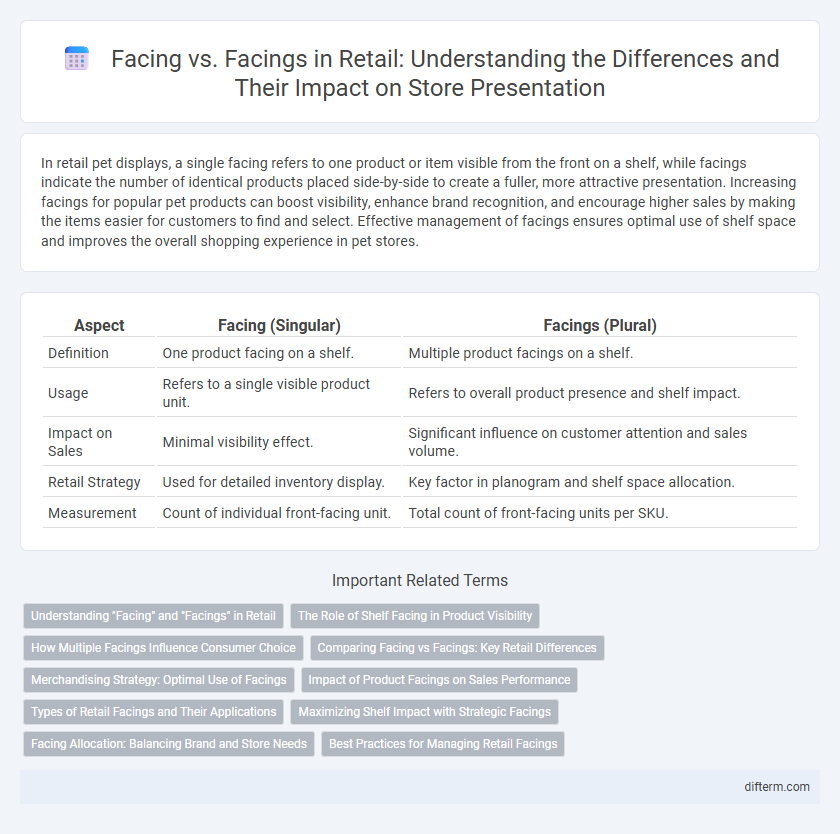In retail pet displays, a single facing refers to one product or item visible from the front on a shelf, while facings indicate the number of identical products placed side-by-side to create a fuller, more attractive presentation. Increasing facings for popular pet products can boost visibility, enhance brand recognition, and encourage higher sales by making the items easier for customers to find and select. Effective management of facings ensures optimal use of shelf space and improves the overall shopping experience in pet stores.
Table of Comparison
| Aspect | Facing (Singular) | Facings (Plural) |
|---|---|---|
| Definition | One product facing on a shelf. | Multiple product facings on a shelf. |
| Usage | Refers to a single visible product unit. | Refers to overall product presence and shelf impact. |
| Impact on Sales | Minimal visibility effect. | Significant influence on customer attention and sales volume. |
| Retail Strategy | Used for detailed inventory display. | Key factor in planogram and shelf space allocation. |
| Measurement | Count of individual front-facing unit. | Total count of front-facing units per SKU. |
Understanding "Facing" and "Facings" in Retail
In retail, "facing" refers to the number of product units visible on the shelf from the customer's perspective, directly impacting product prominence and sales potential. Multiple "facings" increase a product's shelf presence by displaying several units side by side, enhancing brand visibility and encouraging purchase decisions. Retailers strategically manage facings to optimize inventory turnover and maximize shelf space efficiency.
The Role of Shelf Facing in Product Visibility
Shelf facing plays a critical role in product visibility by maximizing the number of product fronts displayed to consumers, directly impacting purchase decisions. Increasing the number of facings enhances a product's shelf presence, making it more likely to attract shopper attention and convey brand prominence. Effective shelf management strategies that optimize facings can significantly boost sales by improving product accessibility and perceived availability in retail environments.
How Multiple Facings Influence Consumer Choice
Multiple facings of a product on retail shelves increase visibility and enhance perceived popularity, directly influencing consumer choice. Studies show that products with a higher number of facings attract more attention, leading to increased sales and brand preference. Retailers strategically allocate facings to optimize shelf space, driving purchase decisions through improved product prominence.
Comparing Facing vs Facings: Key Retail Differences
Facing refers to a single unit of a product displayed on a shelf, while facings indicate the total number of identical product units arranged side by side. Retailers use multiple facings to increase product visibility, shelf presence, and consumer purchase likelihood. Optimizing facings balances inventory levels with merchandising strategies to maximize sales and improve shopper experience.
Merchandising Strategy: Optimal Use of Facings
Merchandising strategy leverages optimal use of facings to maximize product visibility and sales. Increasing the number of facings enhances shelf presence, which directly influences consumer purchase decisions through better brand recognition and perceived availability. Precise allocation of facings based on sales data and category performance drives inventory turnover and improves overall retail profitability.
Impact of Product Facings on Sales Performance
Product facings, or the number of individual product units visible to customers on shelves, significantly influence retail sales performance by enhancing product visibility and consumer purchase intent. Increasing facings for high-demand or flagship items typically boosts sales volume and market share within a category, as shoppers are more likely to select products with greater shelf presence. Retailers optimize facings based on sales data, shopper behavior, and category management strategies to maximize profitability and improve inventory turnover rates.
Types of Retail Facings and Their Applications
Retail facings refer to the visible product units displayed on shelves, directly impacting consumer purchase decisions through accessibility and visibility. Types of retail facings include single facings, cluster facings (multiple units grouped together), and block facings (large, contiguous groupings), each designed to optimize shelf space and enhance product prominence. These different facing strategies are applied based on product category, store layout, and sales goals to maximize brand exposure and encourage impulse buying.
Maximizing Shelf Impact with Strategic Facings
Maximizing shelf impact involves strategically increasing the number of facings for high-demand products to enhance visibility and brand prominence. Each additional facing boosts product exposure, influencing consumer purchasing decisions and driving sales growth. Retailers optimize facings by analyzing sales data and customer preferences to allocate shelf space effectively and maximize profitability.
Facing Allocation: Balancing Brand and Store Needs
Facing allocation in retail involves strategically balancing the number of facings dedicated to each brand to optimize shelf space and maximize sales potential. Allocating appropriate facings ensures prominent visibility for high-demand products while accommodating a diverse product range that meets varying store demographics and customer preferences. Effective facing strategies utilize sales data and market trends to maintain equilibrium between brand representation and overall store performance.
Best Practices for Managing Retail Facings
Retail facings refer to the number of product units visible to customers on shelves, directly impacting product visibility and sales performance. Best practices for managing retail facings include analyzing sales data to optimize product placement, ensuring consistent shelf organization to enhance shopper experience, and collaborating with suppliers to negotiate ideal facing allocations that maximize category profitability. Effective management of facings balances inventory levels with consumer demand, driving increased turnover and stronger brand presence in-store.
Facing vs Facings Infographic

 difterm.com
difterm.com